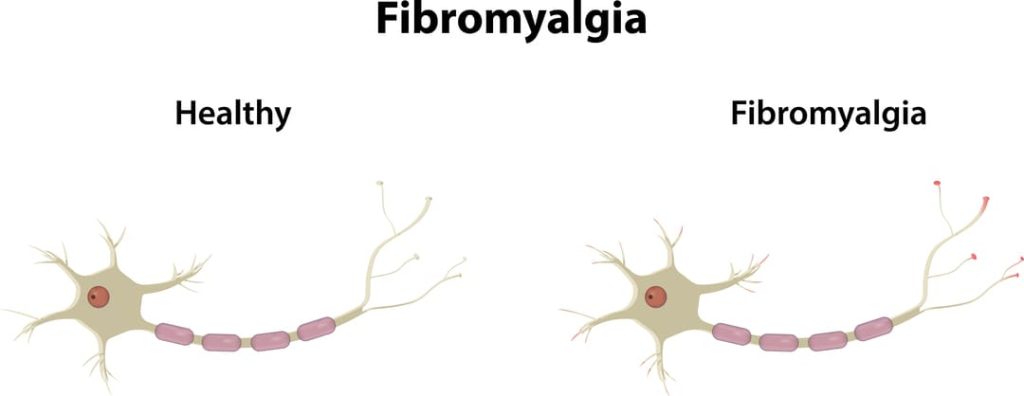Looking for Expert-Level VA Claim Answers?📱Call Us Now! 737-295-2226
Thousands of veterans suffer from fibromyalgia. This complex disorder is characterized by chronic pain and fatigue, making it difficult to complete even the simplest tasks. But there’s something else to consider: VA secondary conditions that could increase your combined VA disability rating and compensation.
This veteran’s guide will explain the top VA secondary conditions to fibromyalgia.
Table of Contents

Fibromyalgia is #32 of the Top 50 Most Common VA Disability Claims. Additionally, many veterans may find that their fibromyalgia leads to debilitating effects in other areas of their life. These disabling conditions include IBS, sleep apnea, insomnia, migraines, chronic fatigue syndrome, and mental health conditions.
The good news is that the VA recognizes fibromyalgia as a primary condition, and any secondary conditions related to it can also qualify for a disability rating. Failing to state these secondary conditions on your VA claim may mean leaving out valuable evidence that could result in a significantly higher VA rating.
When filing your VA claim, it’s important to include medical evidence for these other conditions to increase your overall VA rating.
Veterans and Fibromyalgia
Fibromyalgia is characterized by chronic pain in your muscles, tendons, and other soft tissues. This pain usually increases when any pressure is applied. Areas that tend to be most sensitive include your neck, shoulders, back, hips, arms, and legs.
Fibromyalgia is now a Presumptive Illness For Gulf War Veterans. This makes winning your initial fibromyalgia claim easier if you served in Operations Desert Shield or Desert Storm.
To learn more about filing your initial claim, read our post on How to Win a Fibromyalgia VA Rating.
Let’s jump into our top 7 VA secondary conditions to fibromyalgia.
1. Sleep Apnea Secondary to Fibromyalgia
Sleep apnea is another condition that can be caused or aggravated by fibromyalgia. Symptoms can include frequent daytime fatigue, loud snoring, and waking up in the night gasping for breath. While the exact cause is unknown, experts believe fibromyalgia could affect the muscles and nerves in your airway, which may lead to sleep apnea.
What is the VA rating for sleep apnea secondary to fibromyalgia?
VA ratings for sleep apnea secondary to fibromyalgia can be rated at 0%, 30%, 50%, or 100%, depending on how your symptoms affect your work, life, and social functioning.
For example, you may have a 30% rating for fibromyalgia and then get service connected at 50% for “Sleep Apnea with CPAP” secondary to fibromyalgia.
| Sleep Apnea Secondary to Fibromyalgia VA Rating Scale: | VA Rating |
| Chronic respiratory failure with carbon dioxide retention or cor pulmonale, or requires tracheostomy | 100% |
| Requires use of a breathing assistance device such as continuous airway pressure (CPAP) machine | 50% |
| Persistent daytime hypersomnolence (daytime tiredness) | 30% |
| Asymptomatic but with documented sleep disorder breathing | 0% |
Learn how to win your sleep apnea secondary to fibromyalgia claim in our Complete Guide to Your Sleep Apnea VA Rating.
2. IBS Secondary to Fibromyalgia
Irritable bowel syndrome, or IBS, is a common side effect of fibromyalgia. It can cause digestive difficulties, abdominal cramps and pain, bloating, constipation, or diarrhea. IBS can be a chronic problem, causing significant discomfort as it disrupts daily life for veterans. IBS is a common secondary condition, as it can be brought on or aggravated by various medications, including medications for fibromyalgia.
What is the VA Rating for IBS Secondary to Fibromyalgia?
IBS secondary to fibromyalgia is rated at 0%, 10%, and 30% depending on the frequency, severity, and duration of your symptoms. The highest schedular VA rating for IBS is 30%.
| IBS Secondary to Fibromyalgia VA Rating Scale: | VA Rating |
| IBS severe; diarrhea, or alternating diarrhea and constipation, with constant abdominal distress | 30% |
| IBS moderate; frequent episodes of bowel disturbance with abdominal distress | 10% |
| IBS mild; disturbances of bowel function with occasional episodes of abdominal distress | 0% |
Learn more about filing a winning IBS secondary to fibromyalgia claim with our Top 3 IBS VA Rating Tips.

Deserve a Higher VA Rating?
Book a no-obligation VA Claim Discovery Call with an experienced team member. We’ll review your situation, spot what the VA may have missed, and help you map out a strategy to unlock the VA disability rating and tax-free compensation you’ve earned for your service. Click the red button below to book your call.
3. Migraines Secondary to Fibromyalgia
Migraines are one of the most common VA secondary conditions to fibromyalgia. Many veterans experience painful intense headaches (called migraines), often accompanied by dizziness, confusion, ringing in the ears, and loss of balance. These symptoms can be debilitating—affecting sleep, concentration, physical activity, and work performance.
What is the VA rating for migraines secondary to fibromyalgia?
The VA rates migraines at 0%, 10%, 30%, and 50%. In order to be rated at the highest schedular VA rating of 50%, you must suffer from frequent, prolonged attacks that make you lie down, leaving you unable to work.
| Migraines Secondary to Fibromyalgia VA Rating Scale: | VA Rating |
| Migraines with very frequent, completely prostrating, and prolonged attacks productive of severe economic inadaptability | 50% |
| Migraines with characteristic prostrating attacks occurring on an average once a month over the last several months | 30% |
| Migraines with characteristic prostrating attacks averaging one every two months over the last several months | 10% |
| Migraines with less frequent attacks | 0% |
You can learn more about migraines secondary to fibromyalgia ratings in our post on How the VA Rates Chronic Migraines.

4. Chronic Fatigue Syndrome Secondary to Fibromyalgia
Although these conditions both impact your body in similar ways, it’s also fairly common to develop chronic fatigue syndrome (CFS) if you have fibromyalgia. Your sleep may become even less refreshing, and pain tends to become body-wide instead of isolated to trigger points. You may also develop flu-like symptoms.
It can be difficult for a doctor to diagnose these two conditions separately. Documenting your symptoms and how they change over time will be crucial to proving it’s more likely than not that your fibromyalgia causes your CFS.
What is the VA rating for chronic fatigue syndrome secondary to fibromyalgia?
CFS is rated at 10%, 20%, 40%, 60%, and 100%, depending on your symptoms.
| Chronic Fatigue Syndrome Secondary to Fibromyalgia VA Rating Scale: | VA Rating |
| Debilitating fatigue, cognitive impairments (such as inability to concentrate, forgetfulness, or confusion), or a combination of other signs and symptoms: | |
| – Which are nearly constant and so severe as to restrict routine daily activities almost completely and which may occasionally preclude self-care | 100% |
| – Which are nearly constant and restrict routine daily activities to less than 50 percent of the pre-illness level; or which wax and wane, resulting in periods of incapacitation of at least six weeks total duration per year | 60% |
| – Which are nearly constant and restrict routine daily activities from 50 to 75 percent of the pre-illness level; or which wax and wane, resulting in periods of incapacitation of at least four but less than six weeks total duration per year | 40% |
| – Which are nearly constant and restrict routine daily activities by less than 25 percent of the pre-illness level; or which wax and wane, resulting in periods of incapacitation of at least two but less than four weeks total duration per year | 20% |
| – Which wax and wane but result in periods of incapacitation of at least one but less than two weeks total duration per year; or symptoms controlled by continuous medication | 10% |
| Note: For the purpose of evaluating this disability, incapacitation exists only when a licensed physician prescribes bed rest and treatment. |
Read our post on Chronic Fatigue Syndrome VA Ratings Explained to learn more.
5. GERD Secondary to Fibromyalgia
Gastroesophageal reflux disease (GERD) is a common secondary condition to fibromyalgia, caused by changes in your digestive system that leave you unable to digest food properly. The most common symptoms of GERD are heartburn, regurgitation, and difficulty swallowing.
What is the VA rating for GERD secondary to fibromyalgia?
GERD secondary to fibromyalgia can be rated at 0%, 30%, or 60%. To be rated at the highest schedular VA rating for GERD, you must have frequent, painful attacks that cause vomiting and weight loss or anemia.
| GERD Secondary to Fibromyalgia VA Rating Scale: | VA Rating |
| GERD with symptoms of pain, vomiting, material weight loss and hematemesis or melena with moderate anemia; or other symptom combinations productive of severe impairment of health | 60% |
| GERD with persistently recurrent epigastric distress with dysphagia, pyrosis, and regurgitation, accompanied by substernal or arm or shoulder pain, productive of considerable impairment of health | 30% |
| GERD with two or more of the symptoms for the 30 percent evaluation of less severity | 10% |
Read our Expert’s Guide to GERD VA Ratings Explained to learn how to win your GERD secondary to fibromyalgia claim.

6. Anxiety and Depression Secondary to Fibromyalgia
Anxiety and depression are also common VA secondary conditions to fibromyalgia. The symptoms of fibromyalgia can be incredibly frustrating and isolating for veterans due to the stress placed on the veteran. Additionally, as a veteran dealing with fibromyalgia, you may become less active or withdrawn due to the pain, which can lead to depression.
What is the VA rating for anxiety and depression secondary to fibromyalgia?
With mental health conditions, you’ll receive one VA rating for all conditions (even if you claim both anxiety and depression as secondary to your fibromyalgia). Anxiety and depression are rated at 0%, 10%, 30%, 50%, 70%, and 100%.
| Anxiety and Depression Secondary to Fibromyalgia VA Rating Scale: | VA Rating |
| Total occupational and social impairment, due to such symptoms as: gross impairment in thought processes or communication; persistent delusions or hallucinations; grossly inappropriate behavior; persistent danger of hurting self or others; intermittent inability to perform activities of daily living (including maintenance of minimal personal hygiene); disorientation to time or place; memory loss for names of close relatives, own occupation, or own name. | 100% |
| Occupational and social impairment, with deficiencies in most areas, such as work, school, family relations, judgment, thinking, or mood, due to such symptoms as: suicidal ideation; obsessional rituals which interfere with routine activities; speech intermittently illogical, obscure, or irrelevant; near-continuous panic or depression affecting the ability to function independently, appropriately and effectively; impaired impulse control (such as unprovoked irritability with periods of violence); spatial disorientation; neglect of personal appearance and hygiene; difficulty in adapting to stressful circumstances (including work or a worklike setting); inability to establish and maintain effective relationships. | 70% |
| Occupational and social impairment with reduced reliability and productivity due to such symptoms as: flattened affect; circumstantial, circumlocutory, or stereotyped speech; panic attacks more than once a week; difficulty in understanding complex commands; impairment of short- and long-term memory (e.g., retention of only highly learned material, forgetting to complete tasks); impaired judgment; impaired abstract thinking; disturbances of motivation and mood; difficulty in establishing and maintaining effective work and social relationships. | 50% |
| Occupational and social impairment with occasional decrease in work efficiency and intermittent periods of inability to perform occupational tasks (although generally functioning satisfactorily, with routine behavior, self-care, and conversation normal), due to such symptoms as: depressed mood, Insomnia, suspiciousness, panic attacks (weekly or less often), chronic sleep impairment, mild memory loss (such as forgetting names, directions, recent events). | 30% |
| Occupational and social impairment due to mild or transient symptoms which decrease work efficiency and ability to perform occupational tasks only during periods of significant stress, or symptoms controlled by continuous medication. | 10% |
| A mental condition has been formally diagnosed, but symptoms are not severe enough either to interfere with occupational and social functioning or to require continuous medication. | 0% |
Read our articles on each condition to learn more about winning your anxiety or depression secondary to fibromyalgia VA claim.
7. Insomnia Secondary to Fibromyalgia
Insomnia is a sleep disorder that can be caused or aggravated by fibromyalgia. Symptoms of insomnia include difficulty falling asleep, waking up frequently during the night, and waking up too early in the morning.
This can impact your ability to focus and concentrate during the day. Additionally, due to the chronic pain of fibromyalgia, veterans may experience difficulty finding a comfortable sleeping position.
What is the VA rating for insomnia secondary to fibromyalgia?
Like anxiety and depression, the VA rates insomnia secondary to fibromyalgia at 0%, 10%, 30%, 50%, 70%, and 100%.
You won’t receive a separate rating for insomnia if you’re already being rated for anxiety or depression. Instead, all of your mental health conditions will be combined under one rating.
| Insomnia Secondary to Fibromyalgia VA Rating Scale: | VA Rating |
| Total occupational and social impairment, due to such symptoms as: gross impairment in thought processes or communication; persistent delusions or hallucinations; grossly inappropriate behavior; persistent danger of hurting self or others; intermittent inability to perform activities of daily living (including maintenance of minimal personal hygiene); disorientation to time or place; memory loss for names of close relatives, own occupation, or own name. | 100% |
| Occupational and social impairment, with deficiencies in most areas, such as work, school, family relations, judgment, thinking, or mood, due to such symptoms as: suicidal ideation; obsessional rituals which interfere with routine activities; speech intermittently illogical, obscure, or irrelevant; near-continuous panic or depression affecting the ability to function independently, appropriately and effectively; impaired impulse control (such as unprovoked irritability with periods of violence); spatial disorientation; neglect of personal appearance and hygiene; difficulty in adapting to stressful circumstances (including work or a worklike setting); inability to establish and maintain effective relationships. | 70% |
| Occupational and social impairment with reduced reliability and productivity due to such symptoms as: flattened affect; circumstantial, circumlocutory, or stereotyped speech; panic attacks more than once a week; difficulty in understanding complex commands; impairment of short- and long-term memory (e.g., retention of only highly learned material, forgetting to complete tasks); impaired judgment; impaired abstract thinking; disturbances of motivation and mood; difficulty in establishing and maintaining effective work and social relationships. | 50% |
| Occupational and social impairment with occasional decrease in work efficiency and intermittent periods of inability to perform occupational tasks (although generally functioning satisfactorily, with routine behavior, self-care, and conversation normal), due to such symptoms as: depressed mood, Insomnia, suspiciousness, panic attacks (weekly or less often), chronic sleep impairment, mild memory loss (such as forgetting names, directions, recent events). | 30% |
| Occupational and social impairment due to mild or transient symptoms which decrease work efficiency and ability to perform occupational tasks only during periods of significant stress, or symptoms controlled by continuous medication. | 10% |
| A mental condition has been formally diagnosed, but symptoms are not severe enough either to interfere with occupational and social functioning or to require continuous medication. | 0% |
Learn more about filing an insomnia secondary to fibromyalgia claim with our top tips for winning your insomnia VA claim.
How do you prove your secondary condition was caused by fibromyalgia?
To prove that your secondary condition was caused by your fibromyalgia, you will need to provide detailed medical evidence showing how the two conditions are linked. This includes a diagnosis from a qualified doctor and medical records documenting the progression of both conditions.
The way the VA looks at how your condition is linked to fibromyalgia is important. They want definitive evidence that your condition is “at least as likely as not” caused or worsened by your fibromyalgia.
When your doctor is writing a nexus letter linking your secondary condition to fibromyalgia, the doctor should avoid using words that your condition “may be” or “could be” caused by your fibromyalgia. Instead, they should stick with language that indicates that your fibromyalgia did cause your secondary condition.
Your written account and the results from your Compensation & Pension (C&P) exam will go a long way in proving the link between your secondary condition and your fibromyalgia.
Fibromyalgia can cause or exacerbate a variety of conditions. It is important to be aware of these secondary conditions and understand how they should be rated by the VA. With the right medical documentation, you can get the VA rating you deserve for your secondary conditions!
NEED MORE ASSISTANCE?
Most veterans are underrated for their disabilities and, therefore, not getting their due compensation. At VA Claims Insider, we help you understand and take control of the claims process, so you can get the rating and compensation you’re owed by law.
If you’ve filed your VA disability claim and have been denied or have received a low rating—or you’re unsure how to get started—reach out to us! Our process takes the guesswork out of filing a VA disability claim and supports you in building a fully-developed claim (FDC)—so you can increase your rating FAST! Take advantage of a VA Claim Discovery Call. Learn what you’ve been missing—so you can FINALLY get the disability rating and compensation YOU DESERVE!
About the Author

Trisha Penrod
Trisha Penrod is a former active-duty Air Force officer. As an Intelligence Officer, she led teams of analysts to apply advanced analytic skills to identify, assess, and report potential threats to U.S. forces.
Trisha attended the U.S. Air Force Academy and holds an MBA from Webster University. After receiving an honorable discharge in 2018, Trisha worked as a growth marketer and utilizes her analytic skills to help others accomplish their business goals.


